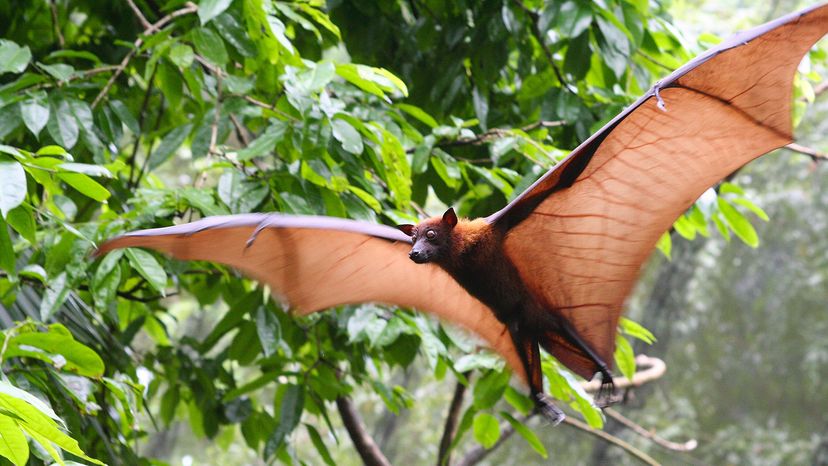Contrary to bats' reputation of being small, rodent-like flying creatures with somewhat unsettling features, the flying fox species are, as their name suggests, reminiscent of foxes, with pronounced snouts and fur that ranges from red to brown to black and white.
Their alternative name is similarly descriptive: fruit bats (since they often feed on fruit, flowers and nectar). Many of these are among the largest bat species in the world, so they deserve their own category.
7. Black Flying Fox
The black flying fox (Pteropus alecto) is a species found in Australia, New Guinea and Indonesia. They have a wingspan that can exceed 39.6 inches (100 cm). These bats feed on pollen and nectar in their tropical habitat.
6. Great Flying Fox
The great flying fox (Pteropus neohibernicus), also known as the Bismarck flying fox, has a wingspan of up to 39 to 47 inches (100 to 120 cm). These bats are endemic to New Guinea, where they forage in the day and night for fruit to eat.
While not considered an endangered species, they are nonetheless under threat from hunting.
5. Madagascan Flying Fox
The Madagascan flying fox (Pteropus rufus), can have wingspans of 39 to 49 inches (100 to 125 cm). They are native to Madagascar, and as their alternative name of Madagascan fruit bat suggests, they get their sustenance mainly from fruit. (The scientific words for this are fructivorous or frugivorous.)
4. Livingstone’s Fruit Bat
The Livingstone’s fruit bat (Pteropus livingstonii) is an especially rare flying fox species, found exclusively in the Anjouan and Mohéli Islands. These bats have a wingspan of 55 inches (140 cm) and are notable for being active during daylight hours.
3. Indian Flying Fox
With a wingspan that ranges from 47 to 59 inches (120 to 150 cm), the Indian flying fox (Pteropus medius) is the largest bat native to the Indian subcontinent.
While mostly frugivorous, this flying fox species has been observed eating insects. Although they are sometimes considered a pest because of their feasting on fruit farms, their feeding habits also help distribute the seeds of these fruits.
2. Large Flying Fox
Runner-up for the title of largest bat by wingspan, the large flying fox (Pteropus vampyrus) — also called the greater flying fox, the Malaysian flying fox and the kalang — is another imposing species that eats fruit, nectar and flowers. Its wingspan often reaches 59 inches (150 cm).
1. Great Golden Crowned Flying Fox
Sitting in the No. 1 spot is the great golden crowned flying fox (Acerodon jubatus), with an average wingspan of 59 to 67 inches (150 to 170 cm).
Also called the golden-capped fruit bat or the giant golden crowned flying fox, the species is currently considered endangered. In its native habitat of the Philippines, its survival is threatened by illegal hunting and deforestation.
